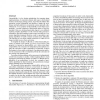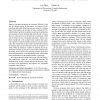225 search results - page 43 / 45 » From sequential programs to concurrent threads |
PLDI
2012
ACM
11 years 10 months ago
2012
ACM
Linearizability is a key design methodology for reasoning about tations of concurrent abstract data types in both shared memory and message passing systems. It provides the illusi...
DAC
2009
ACM
14 years 8 months ago
2009
ACM
Computational complexity has been the primary challenge of many VLSI CAD applications. The emerging multicore and manycore microprocessors have the potential to offer scalable perf...
ISCA
2008
IEEE
14 years 2 months ago
2008
IEEE
Writing shared-memory parallel programs is error-prone. Among the concurrency errors that programmers often face are atomicity violations, which are especially challenging. They h...
HPCN
2000
Springer
13 years 11 months ago
2000
Springer
We build an analytical model for an application utilizing master-slave paradigm. In the model, only three architecture parameters are used: latency, bandwidth and flop rate. Instea...
EUROSYS
2010
ACM
14 years 4 months ago
2010
ACM
Bugs in concurrent programs are extremely difficult to find and fix during testing. In this paper, we propose Kivati, which can efficiently detect and prevent atomicity violat...


